

By Dr Bhargavi Soneji
Senior Physiotherapist
Nov 14, 2025
Modern workplaces have become increasingly sedentary. Between meetings, reports, and endless screen time, most professionals spend 8 to 10 hours sitting at their desks every day. While this setup may be efficient for productivity, it silently takes a toll on health — leading to issues like back pain, neck stiffness, obesity, poor posture, and even cardiovascular risks.
The phrase “sitting is the new smoking” isn’t an exaggeration. Research indicates that prolonged sitting can slow metabolism, decrease calorie burn, and heighten the risk of diabetes and heart disease. You don’t need a gym to stay fit. With a few simple desk exercises, you can improve circulation, strengthen muscles, and maintain energy levels — right at your workstation!
Let’s explore easy, effective desk job fitness ideas to keep your body active and your mind alert throughout the day.
1. The importance of movement at work
Before diving into specific exercises, it’s important to understand why movement is essential for desk workers.
Think of it as an investment in productivity and health — not just another task on your to-do list.
2. Stretching exercises for desk workers
These simple stretches can help ease stiffness and improve flexibility during long periods of sitting.
a. Neck stretch
b. Shoulder shrugs
c. Chest opener
d. Wrist and forearm stretch
3. Seated strength exercises
You can also build muscle tone and endurance while sitting — no gym equipment required!
a. Seated leg lifts
Benefits : Quadriceps and core stability.
b. Chair squats
Benefits: Strengthens glutes, thighs, and core muscles.
c. Seated core twists
Benefits: Activates your oblique muscles and improves spinal mobility.
d. Desk push-ups
Benefits: Strengthens arms, chest, and shoulders.
4. Standing and movement-based exercises
Sitting for long hours is harmful — so, whenever possible, get up and move. These standing exercises are quick, discreet, and effective.
a. Calf raises
Benefits: Improves leg circulation and tones calves.
b. March in place
Benefits: Increases heart rate and relieves stiffness after long periods of sitting.
c. Wall sits
Benefits: Strengthens legs and glutes, and improves endurance.
d. Shoulder blade squeeze
Benefits: Enhances posture and eases upper back tension.
5. Office-friendly movement habits
It’s not just about exercise — small daily changes can make a huge difference in staying healthy at your desk job.
6. Desk ergonomics: Setting up for success
Even the best exercises can’t offset a poor workspace setup. Ergonomic adjustments can prevent pain and improve posture.
7. Mini workouts during breaks
When you have a few extra minutes — like between meetings or during lunch — try these mini workouts:
a. Stair climbing
Skip the lift! Just 5–10 minutes of stair climbing can boost heart health and tone your legs.
b. Desk yoga
A few gentle yoga poses—such as Seated Cat-Cow, Forward Bend, and Eagle Arms—can ease muscle tension and refresh your mind.
c. Resistance band routine
Keep a small resistance band handy — you can squeeze in bicep curls, lateral raises, or seated rows even while on calls!
d. Walking breaks
A quick 10-minute walk around your office or outdoors can refresh your mind and prevent mid-day fatigue.
8. Nutrition and lifestyle tips for desk workers
Fitness isn’t just about movement — it’s also about what fuels your body.
9. The mental health connection
Physical activity isn’t just about keeping your body fit — it plays a vital role in maintaining mental health.
Regular desk exercises
Even a few minutes of movement during your workday can enhance productivity and create a more positive work environment.
You don’t need expensive equipment or a gym membership to stay active. What matters most is consistency. Make it a goal to
By incorporating these desk job fitness exercises, you’ll improve your posture, reduce fatigue, and feel more energetic — both at work and beyond.
Remember, a healthy employee is a productive employee. So next time you’re sitting at your desk for hours, take a moment to move — your body will thank you!